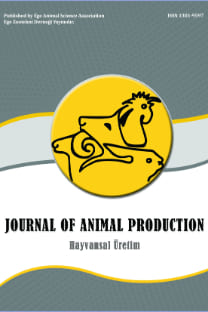Parşömen Üretiminde Kalitenin Artırılması
Parşömen, akrilik polimer, renk ölçümü, FT-IR
___
- Afşar A, Zengin G, Adıgüzel Zengin AC, Kılıçarislan Ç, Yılmaz O, Yılmaz B. 2011. The manufacture of parchment, its importance and usage. International Bergama Symposium, 7-9 April 2011, Bergama, İzmir, s. 313-323.
- Afşar A, Zengin G, Kılıçarislan Ç, Adıgüzel Zengin AC. 2013. A study on improving production quality of parchment. II. International Bergama Symposium, 9-10 May 2013, Bergama, İzmir.
- Bajza H, Hitrec P, Muzic M, Medic D, Krstic D. 2004. Experimental studies in restoration and conservation of historical leather. Journal of the Society of Leather Technologies and Chemists 88:18-22.
- Bicchieri M, Monti M, Piantanida G, Pinzari F, Sodo A. 2011. Non-destructive spectroscopic characterization of parchment documents. Vibrational Spectroscopy 55(2):267–272.
- Budrugeac P, Miu L, Popescu C, Wortmann FJ. 2004. Identıfıcatıon of collagen-based materıals that are supports of cultural and hıstorıcal objects. Journal of Thermal Analysis and Calorimetry 77(3):975–985.
- Cohen NS, Odlyha M, Foster GM. 2000. Measurement of shrinkage behaviour in leather and parchment by dynamic mechanical thermal analysis. Thermochima Acta 365:111-117.
- Cucos A, Budrugeac P, Miu L, Mitrea S, Sbarcea G. 2011. Dynamic mechanical analysis (DMA) of new and historical parchments and leathers: Correlations with DSC and XRD. Thermochima Acta 516:19–28.
- Dandar U, Çolak SM, Deveci R, Adıgüzel Zengin AC, Zengin G. 2014. Skin characteristics of Cervus elaphus L. from republic of tuva in Russia. Journal of the American Leather Chemists Association 109(5):141-150.
- Forbes RJ. 1966. Studies in ancient technology. Vol. V, E.J. Brill, Leiden.
- Gonzalez M, Hernandez E, Ascencio JA, Pacheco F, Pacheco S, Rodriguez R. 2003. Hydroxyapatite crystals grown on a cellulose matrix using titanium alkoxide as a coupling agent. Journal of Materials Chemistry 13:2948-2951.
- Irving T. 2008. The manufacture of parchment and vellum. World Leather. 20-22.
- Maksoud GA. 2000. An Evaluation of selected applied polymers for the treatment of parchment. 15th World Conference on Nondestructive Testing, October 2000, Roma, 15-21.
- Mutlu MM, Crudu M, Maier SS, Deselnicu D, Albu L, Gulumser G, Bitlisli BO, Basaran B, Tosun CC, Adiguzel Zengin AC. 2014. Eco-Leather: Properties of chromium-free leathers produced with titanium tanning materials obtained from the wastes of metal industry. Ekoloji 23(91):83-90.
- Palus JZ, Milczarek JM, Kościelniak P. 2008. Application of infrared spectroscopy and pyrolysis-gas chromatography mass spectrometry to the analysis of automobile paint samples. Chemia Analityczna 53:109-121.
- Reed R. 1972. Ancient skins, parchment and leathers. Seminar Press, London and New York.
- Ryder ML. 1991. Pergament: Geschichte - Struktur - Restaurierung – Herstellung. in: P. Rück (Ed.), Jan Thorbecke Verlag, Sigmaringen, 25-34.
- TS EN ISO 3376. 2012. Deri fiziksel ve mekanik deneyler- çekme mukavemeti ve uzama yüzdesi tayini. Türk Standardları Enstitüsü, Ankara, Türkiye.
- TS 4118-2 EN ISO 3377-2. 2005. Deri fiziksel ve mekanik deneyler-yırtılma yükü tayini bölüm 2: çift kenar yırtığı. Türk Standardları Enstitüsü, Ankara, Türkiye.
- TS 4117 EN ISO 2589. 2006. Deri fiziksel ve mekanik deneyler- kalınlık tayini. Türk Standardları Enstitüsü, Ankara, Türkiye.
- TS EN ISO 2419. 2006. Deri-fiziksel ve mekanik deneyler-numune hazırlama ve şartlandırma. Türk Standartları Enstitüsü, Ankara, Türkiye.
- TS EN ISO 2418. 2006. Deri-kimyasal, fiziksel, mekanik ve haslık deneyleri - numune alma bölgeleri. Türk Standartları Enstitüsü, Ankara, Türkiye.
- Yıldız N. 1993. Eski çağda deri kullanımı ve teknolojisi. Marmara Üniv. Yayınları 540:128.
- Zaki MI, Knozinger H, Tesche B, Mekhemer GAH. 2006. Influence of phosphonation and phosphation on surface acid-base and morphological properties of CaO as investigated by in situ FTIR spectroscopy and electron microscopy. Journal of Colloid and Interface Science 303:9-17.
- Zengin ACA, Crudu M, Maier SS, Deselnicu V, Albu L, Gulumser G, Bitlisli BO, Basaran B, Mutlu MM. 2012. Eco-leather: Chromium-free leather production using Titanium, Oligomeric Melamine-Formaldehyde Resin, and Resorcinol tanning agents and the properties of the resulting leathers. Ekoloji 21(82):17-25.
- Zengin G. 2013. Effective removal of zinc from an aqueous solution using Turkish leonardite-clinoptilolite mixture as a sorbent. Environmental Earth Sciences 70(7):3031-3041.
- ISSN: 1301-9597
- Yayın Aralığı: 2
- Başlangıç: 1974
- Yayıncı: EGE ZOOTEKNİ DERNEĞİ
Sığırlarda İçme Suyu Kalitesi ve Suluk Yönetimi
Keçi ve Koyunlarda Tahta, Kauçuk ve Izgara Zemin Tercihi
Kanatlı Yetiştiriciliğinde Serbest Dolaşımlı Sistemde (Free Range) Besleme Teknikleri
Parşömen Üretiminde Kalitenin Artırılması
Gökhan ZENGİN, Çiğdem KILIÇARİSLAN, Altan AFŞAR, Bekir YILMAZ, Onur Yılmaz, Arife Candaş ADIGÜZEL ZENGİN
Küçükbaş Hayvan Yetiştiriciliğinde Elektronik Tanımlama Sistemlerinin Önemi ve Kullanımı Olanakları
Turgay TAŞKIN, Yavuz AKBAŞ, Mehmet KOYUNCU, Çağrı KANDEMİR, A. Behiç TEKİN, Nedim KOŞUM
Ahmet Engin TÜZÜN, Hayrullah Bora ÜNLÜ
İhsan Bülent HELVA, Mustafa AKŞİT
Sibel SOYCAN ÖNENÇ, Zümrüt AÇIKGÖZ, Figen KIRKPINAR, Tuncay KÜME, Çiğdem ŞEREMET TUĞALAY, Özer Hakan BAYRAKTAR
